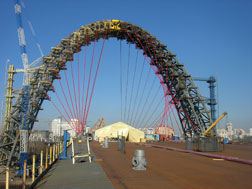 Freyssinet Arch rises more than 80 m above the deck spanning the Moskova River. |
Contractors in Moscow crowned one of the Russian capital's most unusual highway bridges late last month by placing a complete restaurant at the interior apex of a 101.5-m-tall steelwork arch over the Moskova River.
With the 1,000-tonne steelwork pod in place, French engineers are now due to fine-tune 72 stay cables spreading down from the arch to support the Serebryany Bor bridge.
The arch spans nearly 140 meters bank to bank, at right angles to the bridge deck is supports.
That's because the highway there is aligned along the river to avoid disrupting valuable real estate on its banks, says Christophe Blanc, export director with cable contractor Freyssinet International, Paris.
Cable stays have been in place since this May. But final stressing had to wait till after road surfacing was completed and the restaurant module went up.
|
Due to open in late January, the 1.4-km-long bridge with a 409.5-m main span will carry the Krasnopresnenskaya motorway over the river on its way west to the outer ring road.
Designed by architect by OAO Metrogiprotrans, Moscow, with structural work by NGO Mostovik, Omsk, the bridge's arch arrangement is unique, claims the locally-based general contract OAO Mosmetrostroy.
The highway also includes a twin level tunnel under Serebryany Bor (Silver Forest) park in the 7-km stretch leading to the ring road, reports Mosmetrostroy.
To erect the bridge, subcontractor JSC Mostotrest, Moscow, first built the 45-m-wide deck on temporary river supports. It then erected, in modules, the roughly 7,000-tonne arch from both river banks in two self-supporting halves.
The arch, soaring more than 80-m over the deck, is formed by two converging tapering box trusses. The trusses have roughly 10-m sides at the base and they merge as they rise.
Freyssinet began installing cables early this year, allowing bridge loads to be transferred from river supports. The cables vary in length from 45.8-m 198-m to 200-m and contain from 27 to 49 strands each.
Because of limited space, cable anchorages are made of welded steel plates projecting from the arch, reports Guy Sevoz, a senior Freyssinet engineer. And their bearings are spherical to accommodate rotations caused by the restaurant's weight.
With all main loads now in place, the French team must check tensions in all cables and make necessary adjustments, says project manager Bertrand Garin.
Excessive stresses will be relieved by adjusting cable lengths at the anchorage. To increase forces, the contractor will use the original strand-by-strand stressing.
Finally, Freyssinet will install internal radial dampers in the 44 longest cables ahead of the bridge's 2008 opening.


Post a comment to this article
Report Abusive Comment